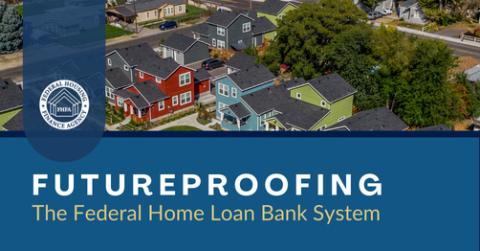By: Joshua Stallings
Families across the country are facing a significant housing affordability and supply crisis. From coast to coast, millions of Americans struggle to find affordable, safe, and decent housing, a challenge that has only intensified in recent years. This is an urgent problem that requires solutions from a variety of stakeholders at the national, state, and local levels.

Historically, when the nation has faced acute housing needs, policymakers and market participants often have risen to the occasion to find ways to make housing more affordable. One of the most significant and lasting solutions was the creation of the Federal Home Loan Bank (FHLBank) System. For more than 90 years, the FHLBanks have been instrumental in providing needed liquidity to member financial institutions that traditionally have been engaged in supporting housing and community development activities for their local communities. However, much about the mortgage market and our financial institutions has evolved since the FHLBanks were established nearly a century ago. As the nation seeks to accelerate the development of affordable housing solutions, clarifying the role of the FHLBank System and strengthening its ability to provide access to stable, reliable liquidity is a critical component of this effort.
Congress established the FHLBank System through the Federal Home Loan Bank Act of 1932 during the depths of the Great Depression, as part of a broader effort to stabilize the housing market and provide greater access to affordable homeownership. At a time when financial institutions across the country were failing and the housing market was in shambles, the new FHLBank System was designed to provide a steady flow of credit to savings and loan institutions and other local mortgage lenders, in the same way the Federal Reserve System supported commercial banks. The goal was simple: enable mortgage lenders to make “sound and economical” home mortgage loans that could place the U.S. housing finance system on stronger footing. In doing so, the FHLBanks were able to help make home ownership more of a reality for potential buyers, and open access for thrifts and community institutions to share in the benefits of the capital markets.
The role of the System has evolved since its origin, both at the direction of Congress and in response to shifts in the mortgage and financial markets. Congress expanded access to membership in the FHLBanks to commercial banks and credit unions in 1989, and to Community Development Financial Institutions (CDFIs) in 2008. The FHLBanks have continued to provide strong liquidity support for their members not only through periods of economic growth and prosperity, but also during periods of market stress and volatility, including the financial crisis of 2007-2008, the COVID-19 pandemic, and the regional bank failures of 2023.
While the current housing landscape is significantly different than at the System’s founding, the FHLBanks continue to be well-positioned to facilitate the flow of capital that allows their members to meet today’s critical housing and community development needs and the challenges of the future. However, there has been a decreased focus on housing activities, such as mortgage lending and servicing, by many institutions that are members of the FHLBank System. At the same time, significant unmet housing needs across the country have placed undue stress on families and communities. Together, these developments demand that the Federal Housing Finance Agency (FHFA) clarify the mission of the System to ensure the FHLBanks continue to serve in the public’s interest.
Providing liquidity, especially to community based financial institutions, will continue to be a fundamental function of the FHLBank System and a priority as the Agency implements recommendations in the FHLBank System at 100: Focusing on the Future (System at 100) report. Local financial institutions have the knowledge and relationships to most effectively serve their communities, and often rely on their FHLBank as a key partner in this work. Membership in the FHLBank System offers these institutions access to capital and the secondary mortgage market, as well as affordable housing and community development programs that, in turn, benefit households across the country.
Under Director Sandra L. Thompson’s leadership, FHFA has remained dedicated to enhancing the FHLBanks’ ability to deliver stable, reliable, and sustainable liquidity to System members supporting housing and community development. The System at 100 initiative is intended to better ensure the System’s viability into its centennial and beyond. Throughout the System at 100 initiative, the Agency has routinely consulted and engaged leaders of the FHLBank System to hear their perspectives and seek collaboration on the Agency’s proposals. In fact, the Agency issued a Request for Input on FHLBank Core Mission Activities and Mission Achievement earlier this year, resulting in more than 230 responses that can be found here: https://www.fhfa.gov/public-input/fhlbank-mission. The Agency will continue to rely on input from stakeholders, including FHLBank members and leadership, consumer organizations, and homebuyers and renters in urban, suburban, and rural communities who have experienced persistent housing affordability challenges, as it implements recommended actions in the System at 100 report.
For the next several months, FHFA will issue a series of proposed rulemakings and guidance to the FHLBanks with the objective of clarifying the System’s mission, membership requirements, and corporate governance. Updates on the Agency’s System at 100 efforts can be found here: https://www.fhfa.gov/programs/fhlbank-system-100/report-implementation and will reflect new announcements and proposed rules.
With the right policies and partnerships in place, the FHLBank System will be best positioned to continue fulfilling its mission of providing liquidity to support housing and community development, in keeping with the purpose envisioned by Congress at the System’s creation.
Joshua Stallings is Deputy Director of the FHFA's Division of Bank Regulation (DBR). DBR is responsible for supervising the FHLBanks and the Office of Finance to ensure their safe and sound operation.